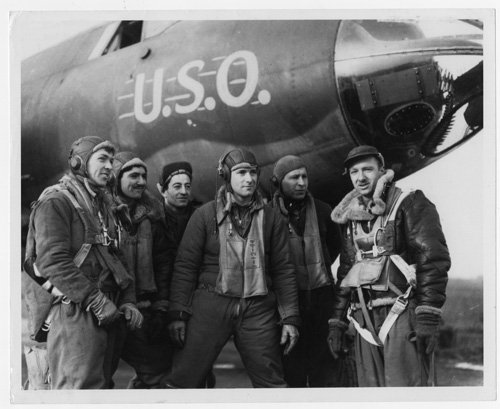Walter Cronkite, correspondent with United Press (UP), poses with the crew of a U.S.O. airplane during World War II. Photo courtesy Cronkite Papers/University of Texas at Austin
LONDON, June 4, 1944 (UP) - Some 4,000 Allied warplanes gave Nazi Atlantic wall fortifications and Nazi military road and rail transport in France and Belgium their worst pasting Saturday, with nearly 1,000 American heavy bombers and fighters pacing the assault with twin attacks on France's Pas-De-Calais and Boulogne areas. Only one fighter plane was lost.
(Early Sunday, the German radio said Allied "nuisance" raiders were over western Germany, approaching the southwestern Reich, the F.C.C. reported.)
More than 2,000 American and British fighters and fighter-bombers swept over hundreds of square miles of occupied territory, bringing railway right-of-ways, highway bridges, radio stations, fuel dumps, air fields, warehouses, military convoys and lone German dispatch riders under their rocket, cannon and machine gun fire.
The air ministry said the attacks on road transport were "among the most comprehensive and successful yet attempted" and disclosed that British planes were completely wrecking the German radio network in northwest Europe - an essential objective of pre-invasion tactical strategy.
While fighters and fighter-bombers staged the greatest Nazi hunt since the pre-invasion blitz opened nearly two months ago, U.S. Flying Fortresses and Liberators twice hammered the French invasion coast, ripped and torn in a 36-hour period under an estimated 8,000 tons of bombs.
Joining the heavy bombers' assault blasting gaps for Allied invasion armies in Field Marshal Gen. Karl von Runstedt's coastal defenses, were hundreds of British and American medium and light bombers.
In a 24-hour period from just before midnight Friday it was estimated that some 4,500 Allied planes attacked France and Belgium.
It was the second time in two days that a great American heavy bomber fleet shuttled the short 22 miles across the English channel to Pas-de-Calais and Boulogne.
The mighty United States Eighth Air Force assault followed a 3,000-ton R.A.F. night attack on the French invasion coast, on the great Trappes freight assembly yards on the outskirts of Paris and on the German chemical center of Leverkusen.
Overnight, too, Italy-based R.A.F. bombers continued attacks on eastern Europe, bombing loading quays and storage tanks at the great Danubian oil port of Giurgiu, 35 miles south of Bucharest, in Romania.
The Pas-de-Calais and Boulogne areas were hit both in the morning and afternoon by the big planes whose bombs were heard clearly from the British cliffs. The attack marked an almost uninterrupted 50 days of assault on the invasion coast.
Escorted by Lightning, Mustang and Thunderbolt fighters, the Flying Fortresses and Liberators flew over a solid cloud blanket. They met no enemy fighters, but some squadrons ran into intense flak, including concentrations of ground rockets - seldom encountered over the coast itself.
Some 500 R.A.F. Halifaxes and Lancasters also encountered strengthened ground rocket defenses over France during the night. Nazi night fighters also rose to defend the already-shattered trapped rail yards and seven were shot down. Seventeen British aircraft were missing from operations that also included mine-laying in German shipping lanes.
The British bombers also reported new enemy ground lights which they believed constituted a German attempt to mark the bombers' course for enemy fighters. The lights were described as an oblong patch slightly larger than a tennis court.
Other R.A.F. forces kept residents in Britain's "Hell Fire Corner" awake as they hurled block-busters on military installations in the Pas-de-Calais area. The Germans reported that the force that kept up the almost unceasing harassment of German chemical industry with an attack on Leverkusen, north of Cologne, included fast-flying Mosquitos.
Meanwhile, the air ministry in London revealed that rocket-firing Typhoons and precision bombing Spitfires piloted by specially trained airmen have been making a series of surprise attacks on radio installations recently, diving to within a few hundred feet of the ground before releasing their rockets.
The air ministry also revealed that during the past four days pilots of Allied tactical air forces had flown another 7,000 sorties, adding greatly to the serious damage inflicted on French transport systems.















